中职英语_book1Unit 7 Seeing a doctor Lesson 2 I
中职英语基础模块第一册第七单元
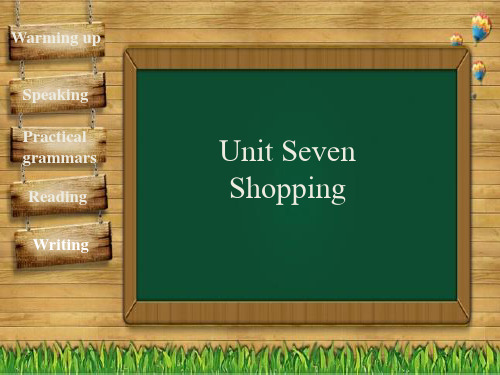
Hello/ Hi! How much does it cost? /
What’s the price? OK. I’ll take it./that’s too expensive…
…………….
Warming up
Speaking
Practical grammars
Reading
Writing
Practical grammars
Warming up
Speaking Practical grammars Reading
Writing
Writing
An apology letter 道歉信
道歉信是用于道歉的一种书信,要求表明诚恳的道 歉态度。格式和一般书信类似。
Sample
Betty,
I’m sorry to tell you I won’t be able to come to the party because I’ve caught a cold and I am feeling unwell, but I wish you a good time.
职教英语第一册Unit7 Reading 课件

)take vacations. occasionlly I usually eat fruits and vegetables ,and _____(偶尔)eat meat. It's annoyed to take a crowded ______(拥挤的)buses after a day's hard work. active活跃的)in life. Dr.Tanaka is over 90,but he is still _____( secret秘密) of living long is to eat well,do a lot of exercise,and The ______( _____(花时间)time with their family and friends.
Practice
1.Read the passage and underline the concluding sentence for each paragraph. Every morning,I eat a good breakfast.I always have fruit and then I have bread and milk.There's a small resturant nearby and I order soup or salad for lunch.For dinner,I usually cook some vegetables and meat and eat them with rice.I think my diet is very healthy. I work and I go to school,so it's hard to find time to exercise.There's a park near my house.I usually walk there for 30 minutes on weekends.Anyway,I don't exercise a lot.
中职英语book1 阶段性测试7单元

阶段性测试(七)Seeing a doctor一、单词拼写1. 疼痛v.2. 劝告、建议3.咳嗽 4. 眩晕的5. 检查6. 感觉7. 发烧8. 头疼9. 伤害10. 注射11. 清淡的食物12. 问题13. 药14. 疼痛n.15. 允许16. 大量的,充足的17. 疲倦的18. 牙疼19. 困难,麻烦20. 担心二.翻译下列短语1. 发高烧2. 远离3. 你怎么了?4. 我感觉不舒服。
5. 流鼻涕6. 担心7. 别着急。
8. 服药9. 充足,大量10. 请两天的假。
11. 打针12. 请病假13. 量体温14. 按时,准时15. 好久不见了。
16. 吃清淡的食物17. 三天的病假18. 好好休息19. 待在床上20. 多做运动三、单项选择(共30小题,每题1分,共30分)1---What’s wrong with you?---I’ve got______headacheA.aB.anC.theD./2.---Is Mr.Green really ill?---______.He is in hospital now.A.I don’t think it isB.No,he isn’tC.I hope soD.I’m afraid so3. Can I take a sick leave___ a day,please?A.forB.inC.ofD.about4.Let’s celebrate our great success,______we?A.willB.don’tC.letD.shall5.I ache______.And I’m feeling very tired after the football match.A.all overB.all aroundC.allD.all our body6.You look very tired.Why not______a rest?A.to stop to haveB.to stop havingC.stop to haveD.stop having7.It’s______.I’ll be OK soon.A.seriousB.nothing seriousC.something seriousD.anything serious8._____read the book alone,Ms.Zhang.A.Let’sB.Let meC.Let usD.Allow9.John,read the text for us,______?A.does heB.will heC.do youD.will you10.---You are not quite yourself,I think you should______.---I think soA.go to doctorB.seethe hospitalB.see a doctor D. go to the hospital11.---______?---I don’t feel comfortable.A. What do you feelB.What about youC.How about youD.how do you feel12.Your hair is too long. You’d better have it_______.A. cutB.to cutC. cuttingD.cutted13.You should keep all the dangerous things______from the babyA. onB. awayC. in touch withD. up14.It’s time______ class. There are no students_______on the playgroundA.for; playB.to; playingC.to; playD.for;playing15.Let me_______your teeth.A.to examineB.examingC.examineD.examined16.The two villages are separated________a small riverA.forB. fromC. byD.at17.I haven’t seen my best friend______we graduated from the collegeA.becauseB. forC. sinceD.as18.I’m not quite myself now. I don’t feel like______.A.to eatB. eatingC. eatD.eatting19. To keep healthy,you’d better______.A. not smokeB. not smokingC. not to smokeD.not to smoking20.The doctor hasn’t known______with Lili.A. what the matter isB.what’s the wrongC. what’s the matterD.what the wrong is21.______careful!It’s dangerous.A. BeijingB.TO beC. BeD. Don’t be22. The doctor advised me_____ in bed and have a good rest.A. stayB.to stayC. stayingD.stayed23.I’m not quite_____today.A. myselfB.meC.ID.my24.A year ago when I hurt my foot,you told me _____it wetA.to not getB.not gettingC.not to gettingD.not to get25.When you have a cold,you should drink______water and have light food.A. a plenty ofB.a plentyC. plentyD. plenty of26.You don’t look _______.What’s wrong with you?A. well B good C. nice D.best27.Hurry up! It’s time______to schoolA. goingB. goC.to goD.went28.Climbing so high made me_______dizzy.A. feelingB.to feelC. feelD. felt29.You should dress warmly if you’re going out_______a cold dayA.atB.inC. onD.for30. Let us go to a movie,_______?A. will youB. shall weC. don’t weD. won’ t you四、阅读理解Did you sleep well last night?Maybe many people will answer:No.In fact, in the world about one third of the people do not have good sleep.If you say you do not have good sleep, it means:waking early and not getting back to sleep.You may get tired, worried and anxious.Your memory and ability to remember things will get worse.Then what should you do when you have the trouble?Do not worry about it too much.Let’s see if you can help yourself.The techniques(技巧)are as follows:First, make sure that your bedroom isn’t too cold or too hot.Keep it dark and quiet.Second, check your lifestyle:Do not drink tea, coffee, cola or chocolate four hours before bed.Drink less water and avoid night-time toilet visits.Set your body clock well by getting up and going to bed at the same time every day.Avoid daytime naps.Develop a relaxing bedtime habit.Read or listen to music, then take a warm bath.If you really can not sleep, try some bread, rice or milk.They will help you fall asleep.Go for a daily walk.Natural light helps you regulate(调理)your body clock, so exercise outdoors if you can.Forget the worries of the day.Write down any worries, thoughts or questions before you go to bed.With these written down, you will have less to think about and your sleep will become easier.(1)What is helpful for your night’s sleep?[] A.Tea.B.CoffeeC.Much water.D.A glass of milk.(2) If you do not have a good sleep, maybe ________.[]A.your bedroom is neither cold nor hotB.your bedroom is dark and quietC.you had a nap in the daytimeDyou took a warm bath before bed(3)This passage is mainly about ________.[]A.what we should drink before bedB.how to get a good sleepC.how to regulate your body clockD.how to develop a relaxing bedtime habit答案:1.D;2.C;3.B;五、补全对话1. ---What’s ________ with you?--- I’m feeling dizzy.2. ---I wish you a good health.--- The ________ you.3. --- ________ do you ________ , Jack?--- I have a bad cough.4. --- I’m feeling tired, and I’ve got a headache.--- You’d better drink ________ ________ water and have a rest.。
中职《英语基础教程》第一册Unit7-1

Unit 7 This is Sara speaking.一、学情分析本单元的话题是接听电话和谈论运动。
教学重点是能够使用基本的电话用语和读懂运动的主题文章。
具体为能够使用基本的电话用语通话;能够读懂志愿者活动的文章;同时培养学生乐于奉献的态度。
本单元的语法点为现在进行时的肯定句、否定句和疑问句。
本单元接听电话和谈论运动这个话题,和学生的日常生活联系比较紧密。
电话用语,学生在以前的学习中也有所接触。
本单元既是对以前词汇和句型学习的一个总结和复习;谈论运动,以往学生学习的更多的是有关运动的种类、活动时间、地点、感受,本单元侧重在运动中的自愿者活动,这是本单元的新内容。
因此,针对新内容设计有趣、实用的教学设计,有效的完成词汇听、说、读、写四个任务,重视运用。
在了解运动赛事和活动的同时,了解运动的体育精神,潜移默化的影响学生的合作、竞争、服务的意识。
注意电话中的礼节。
本单元设计成四个课时:第一课时 Lead in + Listening and speaking第二课时 Reading and writing第三课时Grammar focus (Present continuous tense)第四课时 Vocabulary practice + Supplementary reading二、分课时教学设计第一课时 Lead in + Listening and Speaking一、教材分析1.教学内容本课时系教材《英语基础教程》(1)第七单元的第一课时,包括Lead-in & Listening and speaking两部分,具体内容为:能够使用基本的电话用语通话;复习关于运动项目的单词。
2.教学重点、难点⑴教学重点能够使用基本的电话用语通话;复习关于运动项目的单词。
⑵教学难点在模拟或真实语境中准确使用电话用语。
二、教学目标1.知识目标(1)基本的电话用语,如:take a message,make a phone call,talk on the phone… speaking. /Hello! This is…Hello! This is …. Can/May I speak to …, please?This is…speaking. … isn’t in at the moment.May/Can I take a message?I’m sorry, but ……. now.I’ll tell him/her when he/she’s back.Please tell him/her to …Let him call me at ….. if he has any problems.(2)常见的体育运动词汇,如:football, basketball, tennis, volleyball2.能力目标⑴能够使用基本的电话用语通话;⑵能够在电话中邀约体育运动。
职高英语基本版第1册Unit7GettingAround说课稿

职高英语基本版第1册Unit7GettingAround说课稿第一篇:职高英语基本版第1册 Unit7 Getting Around 说课稿《Unit7.Getting Around》说课教案一、教材(一)教材简析:本课总内容是:中等职业教育国家规划教材,英语基本版1 第7单元(Unit7.Getting Around)前三部分(warm up listening speaking)本节内容为问路及回答(ask for directions and responses)就如何有礼貌地请求帮助问路引出国家语言化背景不同,交流方式,语言行为,交际行为也要受到文化制约,其问路方式也不尽相同。
并由此激发学生对英美文化了解的兴趣。
(二)教学要求:根据教学大纲的要求,结合本课的特点和学生的实际学习情况制定如下目标:知识目标:识记与问路,方向有关单词、词组、句型。
技能目标:运用英语进行交际。
思想目标:通过本节内容掌握不同国家文化背景,热爱生活。
教学重点:掌握如何问路,如何指路,并运用句型进行自由对话。
教学难点:日本人、洛杉机人的不同指路方式及其原因。
二、教法职业中专的学生应着重培养教育学生的实际会话能力,要使学生能够自如的运用英语,在教学当中必须重视启发式教学。
在必要的讲解基础上,运用学生的思维的积极能动性,进行启发式教学,通过英语情境对话,对英语情境更进一步了解,然后再精讲多练,使学生通过模拟练习来掌握教学内容,对教学内容更深一步的理解消化。
因此,我采用以下的教学方法:讲解法,对比法,模拟练习法,情境法,并采用计算机辅助教学。
三、学法学生通过教学过程,进行积极的思维,多动脑,多思考,并结合所学的汉语的知识以及对欧美文化差异的了解,主动积极的掌握基本的问路方式,再学习一些新单词,进一步引出不同国家的不同交流方式,掌握其中要点,流利地动用英语进行交流。
四、教学过程1、复习预备级第四单元寻求帮助的内容,引出新课。
中职英语Unit_7 seeing a doctor1-4
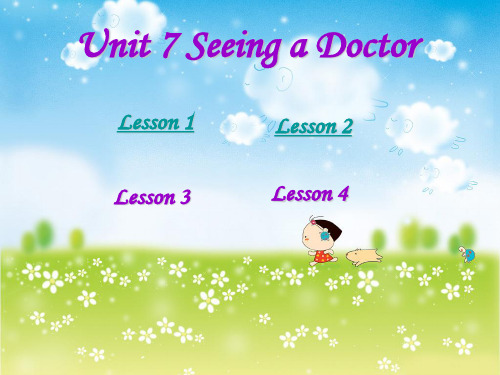
trouble
n.麻烦;烦恼; 故障
What‟s the trouble? 怎么了? What‟s the trouble with you? 你怎么了?
Task 1: Listen and tick
kill
feel
fire
tired
wrong gone
hurt skirt
gather matter
headache
stomachache
cold
fever
toothache
cough
medicinetaFra biblioteke some medicine
examine
examine your eyes
hurt
You are hurting me!
dizzy
Climbing so high made me feel dizzy.
Summary
1. What‟s wrong with you? 2. What‟s the matter with you? 3. I feel tired / dizzy all the time. 4. I have got a headache.
Lesson 2 I have a headache.
finger
hand
Write out each part of the body
leg knee
foot(feet)
toe
Task 2 Listen and answer Dr Smith: What‟s wrong with you? Mary: I have a headache, a running nose and a sore throat. Dr Smith: You may have got a cold. How long have you been like this? Mary: Since two days ago.What should I do then? Dr Smith: Well, there is nothing to worry about. Take it easy. Take the medicine three times a day. Drink plenty of water. Be careful to keep warm. Mary: All right, thank you.
2024年新时代职业英语《通用英语1》教学精彩课件U7
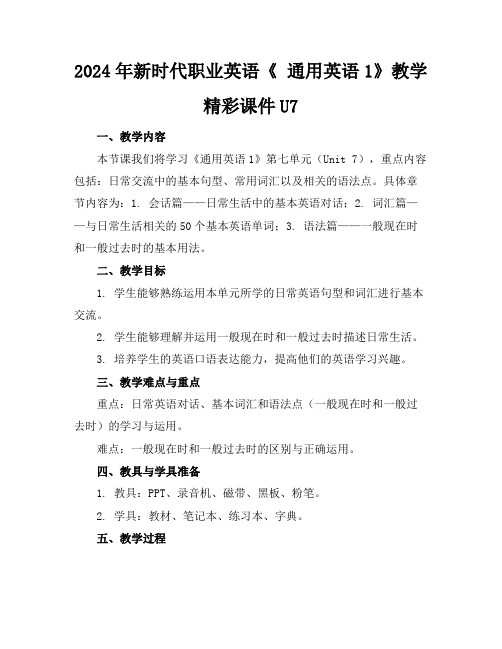
2024年新时代职业英语《通用英语1》教学精彩课件U7一、教学内容本节课我们将学习《通用英语1》第七单元(Unit 7),重点内容包括:日常交流中的基本句型、常用词汇以及相关的语法点。
具体章节内容为:1. 会话篇——日常生活中的基本英语对话;2. 词汇篇——与日常生活相关的50个基本英语单词;3. 语法篇——一般现在时和一般过去时的基本用法。
二、教学目标1. 学生能够熟练运用本单元所学的日常英语句型和词汇进行基本交流。
2. 学生能够理解并运用一般现在时和一般过去时描述日常生活。
3. 培养学生的英语口语表达能力,提高他们的英语学习兴趣。
三、教学难点与重点重点:日常英语对话、基本词汇和语法点(一般现在时和一般过去时)的学习与运用。
难点:一般现在时和一般过去时的区别与正确运用。
四、教具与学具准备1. 教具:PPT、录音机、磁带、黑板、粉笔。
2. 学具:教材、笔记本、练习本、字典。
五、教学过程1. 导入:通过播放一段关于日常生活的英语视频,引导学生关注并模仿其中的英语表达。
2. 新课内容展示:展示PPT,讲解本节课的教学目标和内容,引导学生学习。
3. 互动环节:教师与学生进行对话练习,让学生运用新学的句型和词汇进行交流。
4. 例题讲解:讲解一般现在时和一般过去时的例题,让学生理解并掌握语法点。
5. 随堂练习:布置与新课内容相关的练习题,让学生巩固所学知识。
7. 作业布置:布置课后作业,提醒学生按时完成。
六、板书设计1. Unit 7 Daily Life2. 主体内容:常用句型常用词汇语法点:一般现在时和一般过去时七、作业设计1. 作业题目:(1)根据所给图片,用一般现在时或一般过去时完成句子。
(2)模仿本节课所学的对话,编写一段关于自己日常生活的对话。
2. 答案:(1)略(2)略八、课后反思及拓展延伸1. 反思:关注学生的学习反馈,针对学生的薄弱环节进行针对性教学。
2. 拓展延伸:推荐学生观看与日常生活相关的英语电影、电视剧,提高他们的英语听说能力。
中职英语_book1unit 7 Seeing_a_doctor Lesson 1 What's wrong

unit 7 Seeing_a_doctor Lesson 1 What's wrong Step 1:Learning the new wordsFirst read the new words after the teacher.Second learn the words one by one, and make notes.1.medicine n.medical adj.2.headache n. –ache backache, stomachache , earache,3.examine v. exam n.4.feel feeling5.hurt ---hurt—hurt6.worry --worried7.dizzy feel dizzyStep 2:Learning the sentence patterns1.How are you feeling?= How do you feel?I’m feeling….2.What’s wrong with you?=What’s the matter with you?=What’s the trouble with you?I ache all over.I’m having…I’m not quite myself.I’ve got a …Ask the students to read the patterns again and again, then make up new sentencesStep 3:Read the sentences of task 3Read the sentences and recite them ,then check them.Ask them to pay attention to1.have got a ….2.feel like doing3.feel tired/dizzy4.all the timeStep 4: ask and answer questions of Task 4Step 5: Role play Make up dialogues about his health trouble.Step 6: Do the exercises (学案)Step 7:Homework Recite the sentence patterns and the new wordsLesson 2 I’m feeling terrible.Step 1: Read the joke and answer the questions then do the exercise(学案task1 )Step 2:Listen and complete the exercise1.decide true or false2. find the sentences describing the health3. read the dialogue again and find out the phrasesLook well, ache all over, see a doctor, ask for sick leave, feel terrible, have a fever, have medicine4.remember the phrases.Step 3: Ask and answer questions of Task 3and 41.Students ask questions and answer questions, then give advice with“You’d better…, You should …..”2.Fill in the blanks and practice again and again3.Ask the students to pay attention to “take some medicine, lie in bed, askfor leave”4.How do you feel?I’m feeling dizzy.I feel too tired.I am feeling quite well.I feel sleepy all the time.Step 4:Make up dialogues with the pictures, then practice speaking A:What’s wrong with you?/How do you feel?B:I have a …./ I am feeling….A: Don’t worry. You should / you’d better…B: Thank you.Step 5:Role playMake up dialogues and act it out.Step 6: HomeworkWrite down the dialogues and practice the dialogues.Lesson 3 You should go to see a doctor.Step1:Warming up:1. Show them a short flash2. Ask them a question: what’s this flash about?Step2: While-learningLearning Objectives1. Can offer suggestions to patients.2. Can master the basic usage of imperative sentence3. Can write a sick leave correctly.Ⅰ. Dialogue1. Ask the students to read the dialogue by themselves then finish exercise 1.2. Give them some time to read and remember the phrases.3. Ask them to read the dialogue again and find out the doctor’s advice.Ⅱ. Imperative sentenceObserve the doctor’s advice and guess what grammar points they are.2. Imperative sentence(1) Definition (2) Pass word(3) Ask them to learn the materials by themselves then discuss with theirpartners.(4) Ask them to finish Task 3 Grammar and check the answers later.ⅢRole play1. Give them some time to make a dialogue about seeing a doctor using theimperative sentence learnt.2. Choose some students to show the dialogueⅣSick leave1. Ask them to say the proper form for a sick leave2. Let them to write a sick leave3. Choose two students to read their sick leave.Step 3: Post-learningⅤSummary1.Advice2.Grammar: 祈使句3.Sick leaveⅥHomeworkplete exercise 3, P56 in your exercise book2. Preview lesson4Lesson 4 Do more exercise and keep healthy!Step 1:Fill in the blanks, and read aloudFeel, matter, headache, medicine, healthyRemember the following phrases:Long time no see!What was the matter with you?I had a bad headache.You should do more exercises and keep healthy.Step 2:Match the situations with the advice of Task 2 Match and read the sentences again and again.1.Someone is going out on a cold day.Dress warmly.2. A girl is crossing the street.Be careful.3.The boys are playing computer games.Don’t play the games for too long.4.Someone is tasting some food.Help yourself.Step 3: Practice speaking in pairsUse the sentences withHow are you…?What’s wrong…?What’s the matter with…?Lie in bed, have a good rest, take some medicine, drink more water, have light food, Keep warm, do much exerciseStep 4:Read and write日期Sick leaveDear **,1.原因2. 医生建议3. 请假时间4. 望准假Yours truly,**。
中职英语-book1Unit-7-Seeing-a-doctor--Lesson-2--I

Unit 7 Lesson 2 I have a headache第一课时一教学目标1 知识目标(1)“四会”词组have a headache ,have a stomachache ,have a toothache(2)“四会”句子Wh at’s wrong? I feel very bad today . I have a headache.(3)“三会”词句stay , stay in bed , call ,You look ill .I’ll call the doctor.(4)了解一般将来时态I’ll 的含义及用法。
2 技能目标(1)学习询问身体不适的表达方法:What’s wrong ?(2)学习表达身体不适的句子:I feel…I have …3 情感态度及价值观:学会关心帮助他人,养成乐于助人的好习惯。
二教学重点1 What’s wrong ?的表达方法。
2 正确使用I feel …和I have …三教学难点1 帮助学生理解-ache是用来表达病痛的词缀。
2 帮助学生理解What’s wrong ? 还可完整的表达为Wh at’s wrong with you?3帮助学生理解What’s wrong ? 同义于What’s the matter ?四教学用具录音机,课件,手偶五学习策略师生互动,生生互动合作学习。
六教学过程(一)热身(复习)1唱歌曲body songHello ,boys and girls. Let’s sing a song .OK ? 把学生带入到英语课堂。
2 听音指身体部位T: Point to the head , the stomach , the tooth .为学习身体病痛的词组做一个铺垫,顺便复习了身体部位。
(二)新授1 Free talk 出示课件,一个画面。
病人躺在床上,满脸忧愁,挂着吊针,旁边站着穿白大褂的大夫。
T: Look at the boy , is he happy ? S : No, he is sad.T:Yes ,he is sad. He is ill .Now, read after me ill .板书ill .引出本课的教学内容,这节课我们就来学习与疾病有关的词组及怎样表达身体的不适。
中职英语第一册Unit 7 Seeing a doctor

B. is felt
Do you feel like
(go) to the cinema?
5. keep...away from... 使……远离……
all over: 全部
⑥ trouble 麻烦
10
Unit 2 30. Mr. Smith always gives me
hand when I am in
A.a;/ B.an; the C.the; the
trouble.
D./ ; a
give sb a hand. 给予某人帮助 trouble n. 麻烦,烦恼
A.his going
B.he going
C.he goes
D.he go
n. permission 允许
with one's permission 在某人许可的情况下
without permission 未经许可 → 他未经许可走进了房间。
He went into the room without permission.
What’s the trouble with you?
2. I feel tired / dizzy all the time. 总是,一直
3. I don’t feel like eating.
④ I'm not quite myself.
quite: 很,非常
我不太舒服。 短语: be oneself →身体状态好 by oneself: 单独,独立 ⑤ I ache all over.
新职业英语1unit7

新职业英语1unit7课⽂A 我真的很想知道周五晚上我结束了节⾷。
把去年因常去曼哈顿的餐馆吃饭⽽增加的20磅减掉之后,我敢说我该理直⽓壮地美餐⼀顿了。
为了庆祝节⾷成功,我和太太去了休斯顿⼀家我们最喜欢的餐馆。
饭菜与往常⼀样,味道好极了,服务⽐平常还要好。
我真想给这家餐馆的每个项⽬都打最⾼分,但我没有。
为什么?⼀会⼉我们就知道了。
⼀家公司想度量⼀下顾客满意度是件好事。
但是,要想把这件事做好,整个度量过程必须妥善设计,并⾃始⾄终完整地实施。
合理设计调查问卷仅仅是这个过程的第⼀步。
为了能够从顾客那⾥获得代表性的数据样本,并将偏见降到最低,建⽴数据搜集程序也同样重要。
许多公司却未能做到这⼀点,⽽这也正是这家餐馆的失败之处。
话说我们喝完咖啡之后,侍者拿来了账单。
与账单附在⼀起的,还有⼀份简要的顾客满意度调查问卷。
问卷的⼀⾯是餐馆⽼板的⼀份说明,开头写着“我真的很想知道”;另⼀⾯是⼀些标准的测量项⽬,以及顾客填写意见的空⽩处。
有⼀点不同的是,这份调查问卷已经由侍者填完了。
在“很好”、“好”和“有待提⾼”三个级别上,侍者已经在所有“很好”的⽅框内划了⼀条线。
尽管我很满意这家餐馆的服务,我也不打算把⼀份已由别⼈完成了的调查问卷放到意见箱⾥。
然⽽,很多⼈却会不假思索就将这种问卷交回。
如此进⾏顾客满意度调查,这家餐馆的⽼板只是在愚弄⾃⼰罢了。
如果他“真的很想知道”,在顾客离开时,让⼈给他们分发⼀些邮资已付的调查问卷,会对他更有好处。
如果你正在进⾏或者正打算进⾏顾客满意度调查,我们强烈建议你除了注重问卷的设计外,也要特别注意问卷的发放和回收过程。
课⽂B 摩托罗拉有限产品质量保证书本有限产品质量保证书适⽤于消费者在美国或加拿⼤购买的下列新产品、附件和软件。
*只适⽤于含有该软件的CD-ROM上的缺陷。
如需售后服务或信息,请致电:摩托罗拉客服电话:1-800-453-0920 或954-723-4910或访问我们的⽹站:/doc/ed18597349.html/iden/support您将获得如何将您的产品、附件或软件寄送给摩托罗拉授权维修点的指⽰。
中职《英语基础教程》第一册Unit7-4
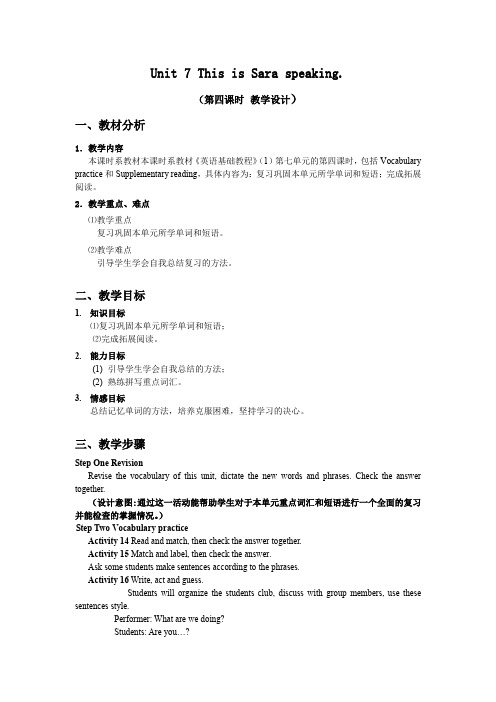
Unit 7 This is Sara speaking.(第四课时教学设计)一、教材分析1.教学内容本课时系教材本课时系教材《英语基础教程》(1)第七单元的第四课时,包括Vocabulary practice和Supplementary reading,具体内容为:复习巩固本单元所学单词和短语;完成拓展阅读。
2.教学重点、难点⑴教学重点复习巩固本单元所学单词和短语。
⑵教学难点引导学生学会自我总结复习的方法。
二、教学目标1.知识目标⑴复习巩固本单元所学单词和短语;⑵完成拓展阅读。
2.能力目标(1)引导学生学会自我总结的方法;(2)熟练拼写重点词汇。
3.情感目标总结记忆单词的方法,培养克服困难,坚持学习的决心。
三、教学步骤Step One RevisionRevise the vocabulary of this unit, dictate the new words and phrases. Check the answer together.(设计意图:通过这一活动能帮助学生对于本单元重点词汇和短语进行一个全面的复习并能检查的掌握情况。
)Step Two Vocabulary practiceActivity 14 Read and match, then check the answer together.Activity 15 Match and label, then check the answer.Ask some students make sentences according to the phrases.Activity 16 Write, act and guess.Students will organize the students club, discuss with group members, use these sentences style.Performer: What are we doing?Students: Are you…?Performer: Yes, we are. / No, we aren’t.(设计意图:由于前面有了听写做基础,完成这几个练习比较简单。
新概念英语第一册第7课
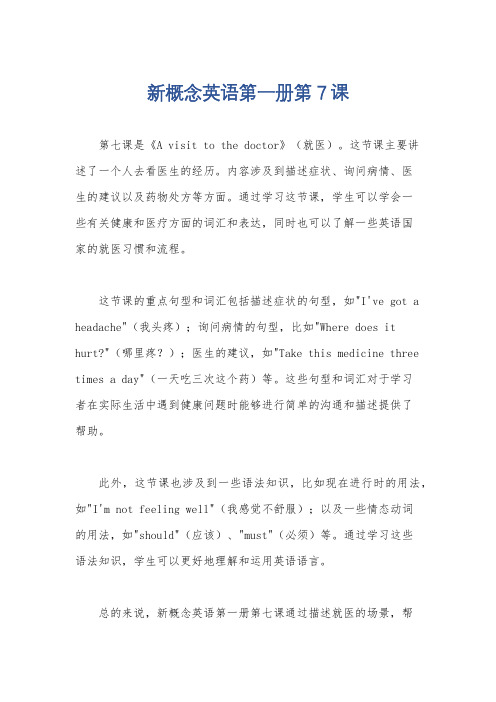
新概念英语第一册第7课
第七课是《A visit to the doctor》(就医)。
这节课主要讲述了一个人去看医生的经历。
内容涉及到描述症状、询问病情、医
生的建议以及药物处方等方面。
通过学习这节课,学生可以学会一
些有关健康和医疗方面的词汇和表达,同时也可以了解一些英语国
家的就医习惯和流程。
这节课的重点句型和词汇包括描述症状的句型,如"I've got a headache"(我头疼);询问病情的句型,比如"Where does it hurt?"(哪里疼?);医生的建议,如"Take this medicine three times a day"(一天吃三次这个药)等。
这些句型和词汇对于学习
者在实际生活中遇到健康问题时能够进行简单的沟通和描述提供了
帮助。
此外,这节课也涉及到一些语法知识,比如现在进行时的用法,如"I'm not feeling well"(我感觉不舒服);以及一些情态动词
的用法,如"should"(应该)、"must"(必须)等。
通过学习这些
语法知识,学生可以更好地理解和运用英语语言。
总的来说,新概念英语第一册第七课通过描述就医的场景,帮
助学生学习相关的词汇、句型和语法知识,为他们提供了在实际生活中进行简单健康对话和沟通的能力。
同时,也让学生了解了英语国家的医疗习惯和文化,为他们的跨文化交流打下了基础。
中专基础模块英语第一册Unit7教案(2)

B. Grammar Activity3: Complete the sentences below with be going to + verb or will + verb. 教学目的:本活动通过填空练习,让学生学会使用正确的一 般将来时形式。 教学建议: 在完成练习的同时,可以让学生找出每一句中的时间暗 示,以帮助学生掌握一般将来时的基本用法。 B. Vocabulary Activity4: How much do you know about your body? Write the names of the body parts at the correct places in the pictures. 教学目的:通过将正确的人体部位名称标注到合适的位置 上,回顾初中所学的人体部位的名称。 教学建议: 1. 可以在练习前带学生浏览一下方框中的词汇,确认 没有生词。 2. 可以在核对答案后根据学生实际情况拓展相关词 汇,如:ear, waist, foot, cheek 等。 3. 可以组织学生用游戏的方式巩固这些称呼,如将学 生按座位分成几个大组,教师可自制一副人体图, 学生蒙上眼睛将身体部位的名称贴在合适的地方, 贴得准确率最高的组获胜。 Activity5: Complete the sentence with the correct words from the box. Change the form if necessary. 教学目的:通过正确的单词填空,让学生复习本单元所学的 重点词汇和表达。 教学建议: 1. 可以在练习前让学生再回顾一下所给的单词。
2. 可以在核对答案时让学生说出整句话的含义。 3. 本活动的拓展可以让学生用部分关键词造句。
Activity2:Read the passage again and circle the correct answer. 教学目的:本活动训练学生捕捉关键信息的能力。
中职《英语基础教程》第一册Unit7-2
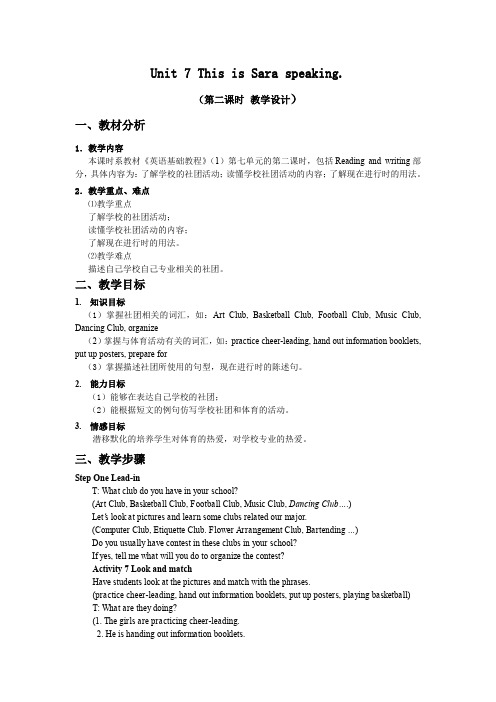
Unit 7 This is Sara speaking.(第二课时教学设计)一、教材分析1.教学内容本课时系教材《英语基础教程》(1)第七单元的第二课时,包括Reading and writing部分,具体内容为:了解学校的社团活动;读懂学校社团活动的内容;了解现在进行时的用法。
2.教学重点、难点⑴教学重点了解学校的社团活动;读懂学校社团活动的内容;了解现在进行时的用法。
⑵教学难点描述自己学校自己专业相关的社团。
二、教学目标1.知识目标(1)掌握社团相关的词汇,如:Art Club, Basketball Club, Football Club, Music Club, Dancing Club, organize(2)掌握与体育活动有关的词汇,如:practice cheer-leading, hand out information booklets, put up posters, prepare for(3)掌握描述社团所使用的句型,现在进行时的陈述句。
2.能力目标(1)能够在表达自己学校的社团;(2)能根据短文的例句仿写学校社团和体育的活动。
3.情感目标潜移默化的培养学生对体育的热爱,对学校专业的热爱。
三、教学步骤Step One Lead-inT: What club do you have in your school?(Art Club, Basketball Club, Football Club, Music Club, Dancing Club….)Let’s look at pictures and learn some clubs related our major.(Computer Club, Etiquette Club. Flower Arrangement Club, Bartending …)Do you usually have contest in these clubs in your school?If yes, tell me what will you do to organize the contest?Activity 7 Look and matchHave students look at the pictures and match with the phrases.(practice cheer-leading, hand out information booklets, put up posters, playing basketball) T: What are they doing?(1. The girls are practicing cheer-leading.2. He is handing out information booklets.3. They are putting up posters.4. The boys are playing basketball.)(设计意图:,通过谈论自己学校的社团,紧密联系学生生活,让学生联系自己的专业,掌握专业队的英文说法。
- 1、下载文档前请自行甄别文档内容的完整性,平台不提供额外的编辑、内容补充、找答案等附加服务。
- 2、"仅部分预览"的文档,不可在线预览部分如存在完整性等问题,可反馈申请退款(可完整预览的文档不适用该条件!)。
- 3、如文档侵犯您的权益,请联系客服反馈,我们会尽快为您处理(人工客服工作时间:9:00-18:30)。
Unit 7 Lesson 2 I have a headache
第一课时
一教学目标
1 知识目标(1)“四会”词组 have a headache ,have a stomachache ,have a toothache
(2)“四会”句子What’s wrong? I feel very bad today . I have a headache.
(3)“三会”词句 stay , stay in bed , call ,
You look ill .
I’ll call the doctor.
(4)了解一般将来时态I’ll 的含义及用法。
2 技能目标(1)学习询问身体不适的表达方法:What’s wrong ?
(2)学习表达身体不适的句子:I feel…
I have …
3 情感态度及价值观:学会关心帮助他人,养成乐于助人的好习惯。
二教学重点
1 What’s wrong ?的表达方法。
2 正确使用I feel …和I have …
三教学难点
1 帮助学生理解-ache是用来表达病痛的词缀。
2 帮助学生理解What’s wrong ? 还可完整的表达为
What’s wrong with you?
3帮助学生理解What’s wrong ? 同义于What’s the matter ?
四教学用具
录音机,课件,手偶
五学习策略
师生互动,生生互动合作学习。
六教学过程
(一)热身(复习)
1唱歌曲body song
Hello ,boys and girls. Let’s sing a song .OK ? 把学生带入到英语课堂。
2 听音指身体部位
T: Point to the head , the stomach , the tooth .为学习身体病痛的词组做一个铺垫,
顺便复习了身体部位。
(二)新授
1 Free talk 出示课件,一个画面。
病人躺在床上,满脸忧愁,挂着吊针,旁边站着穿白大褂的大夫。
T: Look at the boy , is he happy ? S : No, he is sad.
T:Yes ,he is sad. He is ill .Now, read after me ill .板书ill .引出本课的教学
内容,这节课我们就来学习与疾病有关的词组及怎样表达身体的不适。
2 T: I have a headache.
I have a stomachache.
I have a toothache.
I feel bad . I feel ill.表现出头痛,肚子痛,牙痛,不舒服。
让学生跟读并一起做动作。
然后同桌练习,一个人说单词,另一个人做动作。
3 老师拿两个手偶,扮演不同的角色,展开对话。
T: What’s w rong ? T: I have a headache.
T: What’s the matter? T: I have a stomachache.
T: What’s wrong with you ? T: I have a toothache.
让学生跟读,并作动作,引出What’s wrong ?的含义。
并帮助学生理解What’s wrong ?
还有另两种说法。
在学生熟悉了句子后,可以一名学生发出口令,其他学生做动作。
4 听课文录音,学习课文。
先听第一部分三遍,让学生一句一句跟读,然后齐读,在熟
读的基础上背诵。
听第二部分两遍,老师讲解。
然后跟读。
5 小组活动。
创设一个情景,一位同学肚子痛,另一位同学看见了并关心的询问,而且
把他送往医院的对话。
让小组练习并上台表演,让学生体验关心帮助他人,养成乐于助人的好习惯。
(三)作业
1请同学们做一件好事,关心帮助周围的人,结合本课所学内容,编成一个小对话。
2 抄写重点单词和句子。
七板书设计
Lesson 10 I have a headache
What’s wrong ? I have a headache.
(What’s the matter?) I have a stomachache. ill
I have a toothache.
I feel very bad today.
八教学反思
本课借助一首Body song 复习导入,在学生熟悉了身体部位后,紧接着出示课件图片,让学生讨论,引出本课的教学内容。
在整个课的讲授过程中,我始终采取直观性的教学方法,用画面引出新课,用手偶展示对话,用动作演示身体部位。
始终遵循英语的六大教学原则,思想性原则,趣味性原则,实践性原则,交际性原则,准确性原则,灵活性和创造性原则。
